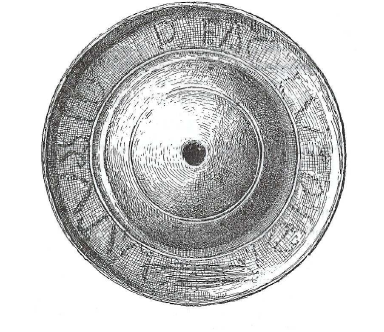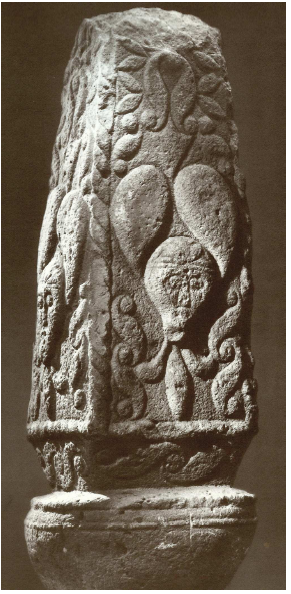2) Intoxication to establish a ‘dialogue’
a) The ‘Listening Goddesses’: Clutoiθa and the Rokloisiabo
To make contact with the divine, the absorption of alcoholic drinks or hallucinogenic substances was certainly often accompanied by specific rituals, dances, songs, incantations and musical instruments, which played the role of a physical stimulant and constituted a mode of identification for the gods.2222 Indeed, in Gaul, an inscription dedicated to Dea Clutoiθa, discovered in Etang-sur-Arroux (Saône-et-Loire), in the territory of the Aedui, was engraved on an ancient musical instrument, called a crotalum (fig. 3). The inscription reads: Dea(e) Clutoidae Elatussio(?), ‘To the goddess Clutoida Elatussio(?) (offered this)’.2223 The dedicator Elatussio has a Gaulish name and bears the unique name; he is thus a peregrine.2224 A crotalum is composed of two small cymbals or castanets pierced in the middle on the upper scallop, which were used as percussion, by banging the two parts together. It was used to arouse and draw the attention of a deity, so that the pilgrims’ prayers could be heard and then be granted. There are several other representations in Gaul of such an instrument, held by goddesses or by their believers,2225 such as the statue of the goddess from Cosne, which has her laying her hand on a crotalum,2226 or the representation of a young boy, holding such an instrument in his right hand, on a funerary stele* from Autun.2227 The goddess Clutoiθa is honoured in another inscription discovered in Mesves-sur-Loire (Nièvre), in the territory of the Aedui: Aug(usto) sacr(um) deae Cluto[i]dae et v(i)canis Masavensibu[s] Medius Acer Medianni [f(ilius)] murum inter acrus duos c[um] suis ornamentis d(e) s(uo) d(edit), ‘Sacred to Augustus, to the goddess Clutoida and to the deities of the inhabitants of the vicus of Masava. Medius Acer, son of Mediannus, had this wall erected between two archways with its ornaments’.2228

The divine name Clutoiθa is derived from the Gaulish cluto-, clouto-, ‘renowned’ or ‘famous’, cognate with Old Irish clú (genitive cloth), Welsh clod, ‘reputation’ or ‘famous’ and Greek klutόs, ‘renowned’, all derived from the IE root *kleu-, ‘to hear’ or ‘to listen to’.2229 Kluto- is an adjectival derivative with a suffix of passive participle –to-, which pertains to what is heard, that is ‘glory’ or ‘fame’, and thus means ‘renowned’ or ‘famous’.2230 The meaning of the second element of her name iθa remains unclear, because scholars do not know to which sound the Greek letter theta θ could correspond. Lambert and Delamarre suggest that θ might have stood for an affricate and that iθa could thus be read issa. iθa could be envisaged either as a suffix or as a second compound element.2231 If Clutoiθa is a compound, it may be understood as *kluto-wid-ta, with kluto- ‘renowned’ and the IE root wid- signifying ‘to know’. Clutoiθa would thus mean ‘Of the Renowned Knowledge’. Lambert however underlines that the noun of action of the theme ‘knowledge’ is not wid-ta but wid-tu- in Celtic.2232 Kluto- could be based on another verbal root, such as the IE root wedh- ‘to lead’ and be split up as *kluto-wedh-to, that is ‘the One who Leads to Glory’.
Given that the inscription from Etang-sur-Arroux is engraved on a musical intrument aiming at awakening the deity, Hatt argues that Clutoiθa may have been associated with the gift of listening.2233 He relates her to the Rokloisiabo, the mother goddesses invoked in a Gallo-Greek inscription discovered in 1950 on the archaeological site of Saint-Rémy-de-Provence (Bouches-du-Rhône) (fig. 4). The inscription, offered by a woman peregrine bearing a Latin name, is the following: κορνηλια κλοισαβο βρατουδεκαντ, ‘Cornelia, to the Roklosiabo, in gratitude, on the accomplishment of a vow (or with the tithe)’.2234 Lejeune has suggested that Rocloisiabo is composed of an intensive ro-, signifying ‘great’; of a root kloisio-, deriving from the IE *kleu(s), ‘to hear’; and a plural dative bo.2235 The Rokloisiabo would therefore be ‘The Great Listeners’ or ‘The Ears’. It must be borne in mind, however, that, like Clutoiθa, their name may also mean ‘The Very Renowned Ones’.

While some goddesses would specifically personify the rites of intoxication, as we are going to show, it seems that other goddesses, such as Clutoiθa and the Rokloisiabo, the benevolent ‘Listeners’, could be the very representation of the belief that pilgrims could enter into dialogue with a deity, be listened to and have their vows granted. They may have been ‘divine ears’ which could be reached and awakened through the performance of various rites. They might have eventually been perceived or personified as ears. This is very probable since a 1st- or 2nd-century AD altar, bearing the inscription Auribus, ‘To the Ears’, accompanied with a figuration of two ears surrounded by a crown of laurels, was also discovered on the archaeological site of Saint-Rémy-de-Provence (Bouches-du-Rhône) in 1937.2236 Here the Listening Goddesses are reduced to the figurative representation of the organ which enables listening: the ear. As Lejeune has pointed out, there is an obvious connection between this inscription in Latin, which is probably a Latinized version of a Celtic formula, and the Rokloisiabo. It seems that this idea of divine listeners is also pictured on a small obelisk from Pfalzfeld (Germany), dated 4th c. BC, on which we can see a god with two enormous ‘leaves’ coming from the two sides of his head, at the ear level (fig. 5). These ‘leaves’ could be the ears of the god, which are disproportionately represented on purpose, for it lays stress on the divine ability of listening to the pilgrims.
